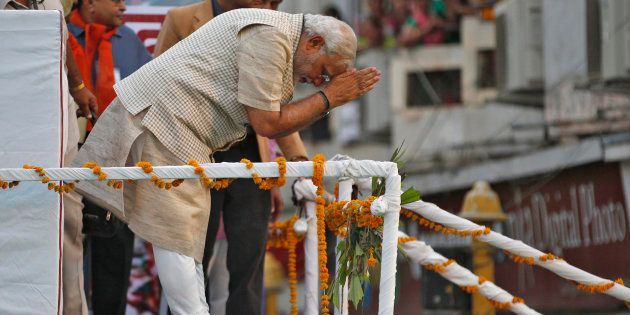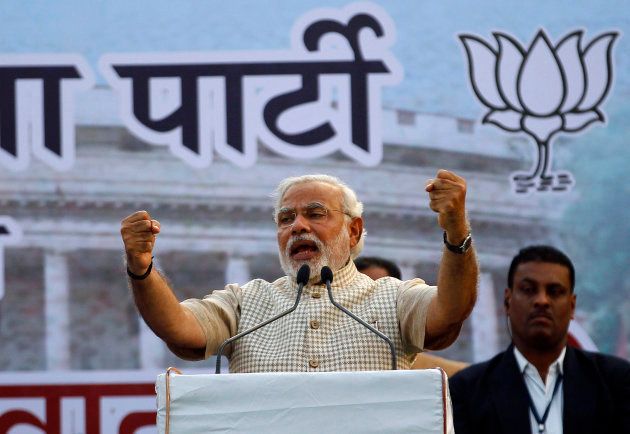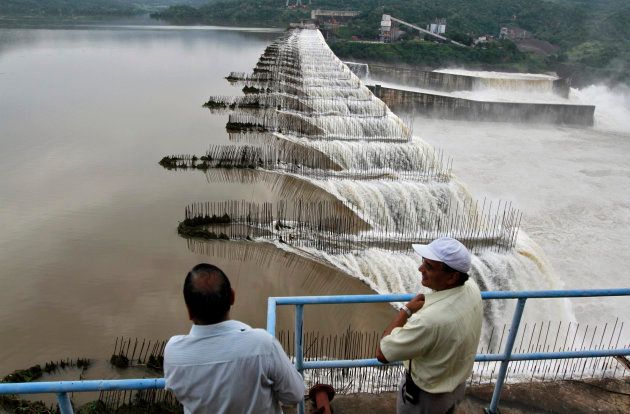
Two days after Congress leader Ahmed Patel retained his Rajya Sabha in Gujarat, belying the Bharatiya Janata Party's expectations and calculations and considerably depressing its leadership's morale, came a spoonful of tonic for the saffron party's president Amit Shah, from Prime Minister Narendra Modi.
Shah, predisposed to taking risks and almost always pulling off his gambles, was widely believed to have authored the latest venture to fight a third seat in Gujarat in the Rajya Sabha polls, although the odds favoured Patel, Sonia Gandhi's political secretary.
Despite six of its MLAs cross-voting the NDA candidate in last month's presidential poll and subsequently resigning, the Congress had sufficient first preference votes to see its candidate through. Still, Shah was determined to make a contest of Patel's seat and pulled out all the stops to defeat him. He eventually could not. However, BJP insiders maintained that Shah's idea was green-flagged by Modi and its execution was closely monitored by the PM.

When Patel pipped the BJP nominee, the momentary shock in the BJP was palpable: its leaders and functionaries wondered whether Shah had over-relied on the rebel Congress leader Shankersinh Vaghela to reach the winning post.
Modi set to rest the internal doubts over Shah when he lauded him for completing three years as the party chief and on being elected to the Rajya Sabha in a meeting of the BJP parliamentary party. Shah attended it for the first time as an MP. Members quoted Modi saying that Shah had returned the "culture of hard work" that used to be the hallmark of the BJP's progenitor, the Bharatiya Jana Sangh.
To begin with, the BJP will launch a "rath yatra", covering 10,000 villages in 24 districts that will be fed by Narmada waters flowing from the humungous Sardar Sarovar dam that was just completed.
The PM remarked that while it was easy to run a political party while in the Opposition, it was difficult doing it when it was in power. Praise over and done with, the BJP steeled itself to leave the Patel episode behind and get on with its preps for the Gujarat elections, due in November-December even as sources admitted that the "shock" Congress win had surcharged the party's "inert" workforce.
To begin with, the BJP will launch a "rath yatra", covering 10,000 villages in 24 districts that will be fed by Narmada waters flowing from the humungous Sardar Sarovar dam that was just completed. The "yatra", that was supposed to have begun in July, was put off because of the heavy rains and the ensuing floods. Modi was to dedicate the dam to the nation. It is billed as one of the "biggest achievements" of the NDA and Gujarat governments because the BJP has consistently alleged that the Congress did "nothing" for decades to implement the project because it had "caved in" before protests over the dam's ecological and human costs.

Since his first election in 2002, Modi presaged the arrival of each one of them in Gujarat by going on a "yatra" loaded with emotive messages that were linked to the state's "asmita" (self-respect) and "gaurav" (pride) and its youths who were exhorted to emulate his idol, Swami Vivekananda.
The still-to-take-off Narmada "yatra" has been invested with emotion and sentiment because one of the accompanying slogans, coined by Gujarati writer Jay Vasavada, will be "Namo Narmadey, Sukhe Sarvadey" (I bow before Narmada, she brings welfare to all).
Although Modi is expected to dedicate the dam to the nation, the BJP has already made Sardar Sarovar synonymous with Gujarat. Speaking at the parliamentary party meet, Shah attacked the Congress for taking an "anti-Gujarat" stance by stalling the dam's implementation. He was quoted as saying, "The Congress's stand always remained anti-farmer."
"Though the Narmada Control Authority had already completed the formalities to raise the (dam's) height before June 2014, they (UPA government) did not give consent. But PM Modi gave it within one month of assuming office," he said.
The BJP's tag line will be that the dam will mark the transition of Gujarat from a rain-fed agrarian economy, susceptible to frequent droughts, to canal-based irrigation that will water the "last village" of Kutch.
The BJP's tag line will be that the dam will mark the transition of Gujarat from a rain-fed agrarian economy, susceptible to frequent droughts, to canal-based irrigation that will water the "last village" of Kutch.
In step with Modi's penchant for selling big ideas, underpinned on the Jana Sangh ideologue Deen Dayal Upadhayay's concept of "antodaya" (touching the last person waiting in the queue), Sardar Sarovar's centrepiece will be SAUNI or the Saurashtra Narmada Avtaran Irrigation, a project conceptualised solely for the arid Saurashtra region that also has the highest number of assembly seats and holds the key to a party's success.
SAUNI envisages filling 115 major dams of Saurashtra with water overflowing from the Sardar Sarovar dam in south Gujarat. But north Gujarat, subject to weather vagaries and usually in the throes of a drought or floods as the recent one, and Kutch have been marked out as the biggest beneficiaries of the Sardar dam.
North Gujarat that includes the districts of Mehsana, Gandhinagar, Sabarkantha and Banaskantha has been a weak area for the BJP. Vaghela, who has quit the Congress, is a chieftain of this region but holds sway over his own caste, the Thakores and some backward castes. The Patels of north Gujarat revolted against the BJP, following Hardik Patel's call for reservation in education and jobs.
The BJP is playing the caste card earnestly in the state, attempting to band together a huge bank of backward caste voters.
Hardik's street protests, backed covertly by the Congress, cost the BJP its Patel support in the 2015 local bodies' election. Nothing much has been heard of the young fighter but the BJP hoped the Narmada waters will cool Patel tempers in the northern districts.

Once watered by the river, north Gujarat is projected to become the second home of the "White Revolution" that unrecognisably changed the face of central Gujarat decades before and usher in economic prosperity.
The BJP is playing the caste card earnestly in the state, attempting to band together a huge bank of backward caste voters. For the Patel malcontents, Narmada and the vision of development and growth have been thought up as palliatives.